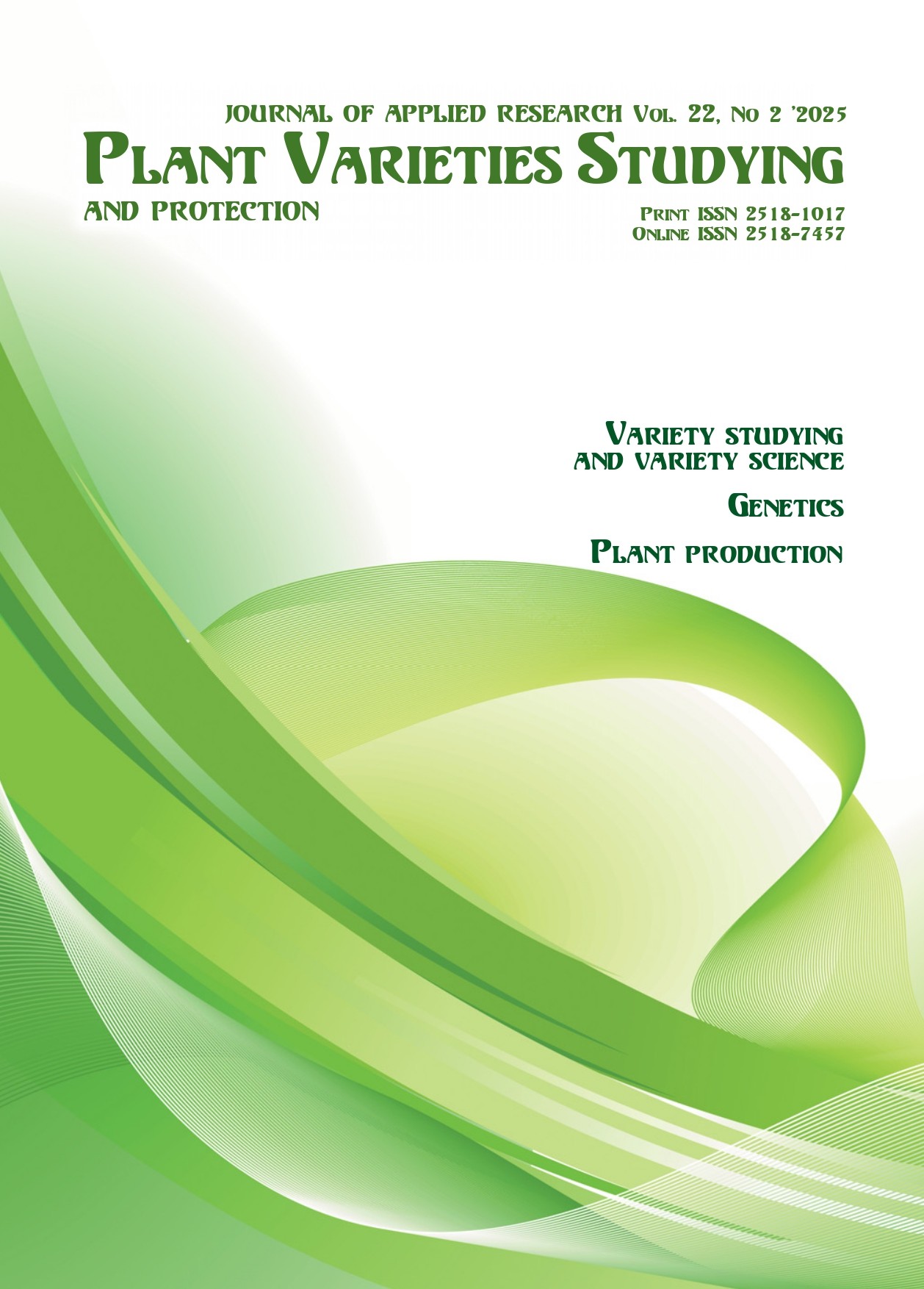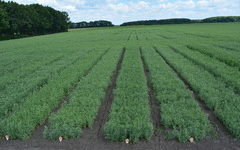Dependence of sugar beet seed sowing qualities on zinc-containing preparation treatment
DOI:
https://doi.org/10.21498/2518-1017.21.2.2025.333452Keywords:
hybrid, germination energy, laboratory germination, laboratory experiment, optimal dose, varietal characteristicsAbstract
Purpose. To establish the optimal rate of application of YaraVita Teprosyn NP+Zn preparation, to ensures the highest sowing quality of sugar beet seeds. Methods. Biological (conducting laboratory experiments) and statistical (descriptive statistics, variance, correlation and regression analyses). Results. Laboratory studies showed that the variation in the germination energy of sugar beet seeds depends to some extent on their treatment with the YaraVita Teprosyn NP+Zn fertiliser preparation (15.5%), as well as on the seed batch (12.7%). However, genetic differences between the domestic hybrids studied had the greatest influence (61.1%). As for the variation in laboratory similarity, 41.6% was caused by the aforementioned fertiliser and 36.7% by genetic differences. The germination energy of the seeds also changed depending on the application rate of YaraVita Teprosyn NP+Zn. Specifically, germination energy increased to 84.9% when 3 l/t was applied (compared to 80.7% for the control variant), and to 88.6% when 6 l/t was applied. Increasing the amount of fertiliser further to 9 l/t did not significantly affect germination energy; in fact, using the maximum rate for the experiment (12 l/t) reduced it to 86.9%. An increase in laboratory germination was achieved by treating the seeds with YaraVita Teprosyn NP+Zn at rates of 3 and 6 l/t, increasing the percentage from 86.6% (control) to 91.8% and 96.6%, respectively. However, a further increase in the amount of fertiliser to 9 or 12 l/t resulted in a decrease in laboratory germination. In these variants of the experiment, the figures were 96.3% and 91.9%, respectively. Regression equations were established to predict the germination energy and laboratory germination of seeds, as well as to optimise the application rates of YaraVita Teprosyn NP+Zn. Conclusions. The optimal application rate of the zinc-containing preparation YaraVita Teprosyn NP+Zn for maximising the germination energy of sugar beet seeds was found to be 9 l/t for the 'ITsB 0904' hybrid and 6 l/t for the 'Ruteniia 11' hybrid. The highest laboratory germination rate was achieved using 6 l/t of this fertiliser. However, exceeding the optimal rates can lead to inhibition of germination, although the genetic potential of the hybrid is also important for this. It can also lead to a decrease in laboratory germination, which is primarily influenced by treatment with the specified zinc-containing preparation. The developed regression models are valuable tools for predicting sowing quality and the rational use of YaraVita Teprosyn NP+Zn fertiliser under production conditions.
Downloads
References
Dohm, J. C., Minoche, A. E., Holtgräwe, D., Capella-Gutiérrez, S., Zakrzewski, F., Tafer, H., Rupp, O., Sörensen, T. R., Stracke, R., Reinhardt, R., Goesmann, A., Kraft, T., Schulz, B., Stadler, P. F., Schmidt, T., Gabaldón, T., Lehrach, H., Weisshaar, B., & Himmelbauer, H. (2013). The genome of the recently domesticated crop plant sugar beet (Beta vulgaris). Nature, 505(7484), 546–549. https://doi.org/10.1038/nature12817
 |
| 
Shpaar, D. (Ed.). (2005). Sugar beets (growing, harvesting, storage). National Scientific Center “Institute of Agrarian Economics”. [In Ukrainian]
Hanzhenko, O. M. (2023). Agroecological foundations of the formation of productivity of sugar crops for biofuels. Nilan-LTD. [In Ukrainian]
Usmani, Z., Sharma, M., Diwan, D., Tripathi, M., Whale, E., Jayakody, L. N., Moreau, B., Thakur, V. K., Tuohy, M., & Gupta, V. K. (2022). Valorization of sugar beet pulp to value-added products: A review. Bioresource Technology, 346, Article 126580. https://doi.org/10.1016/j.biortech.2021.126580
 |
| 
Tse, T. J., Wiens, D. J., & Reaney, M. J. T. (2021). Production of Bioethanol – A Review of Factors Affecting Ethanol Yield. Fermentation, 7(4), Article 268. https://doi.org/10.3390/fermentation7040268

Beigbeder, J.-B., de Medeiros Dantas, J. M., & Lavoie, J.-M. (2021). Optimization of Yeast, Sugar and Nutrient Concentrations for High Ethanol Production Rate Using Industrial Sugar Beet Molasses and Response Surface Methodology. Fermentation, 7(2), Article 86. https://doi.org/10.3390/fermentation7020086

Ćirić, M., Popović, V., Prodanović, S., Živanović, T., Ikanović, J., & Bajić, I. (2024). Sugar Beet: Perspectives for the Future. Sugar Tech, 26(5), 1208–1219. https://doi.org/10.1007/s12355-024-01462-5

Prysiazhniuk, O. I., Prysiazhniuk, L. M., Melnyk, S. I., & Hryniv, S. M. (2022). Sugar beet – breeding, seed production and cultivation technology. Tvory. [In Ukrainian]
Hospodarenko, H. M. (Ed.). (2020). Agrochemical component of sugar beet growing technology. SIK HRUP Ukraina. [In Ukrainian]
Zhao, X., Song, B., Ishfaq, M., Adil, M. F., Lal, M. K., Wu, Z., Jia, Q., & Huang, W. (2023). Zinc amendment increases the yield and industrial quality of Beta vulgaris L. cultivated in Northeast China. Field Crops Research, 298, Article 108973. https://doi.org/10.1016/j.fcr.2023.108973

Ghadirnezhad Shiade, S. R., Fathi, A., Taghavi Ghasemkheili, F., Amiri, E., & Pessarakli, M. (2022). Plants’ responses under drought stress conditions: Effects of strategic management approaches – a review. Journal of Plant Nutrition, 46(9), 2198–2230. https://doi.org/10.1080/01904167.2022.2105720

Zewail, R. M. Y., El-Gmal, I. S., Khaitov, B., & El-Desouky, H. S. A. (2020). Micronutrients through foliar application enhance growth, yield and quality of sugar beet (Beta vulgaris L.). Journal of Plant Nutrition, 43(15), 2275–2285. https://doi.org/10.1080/01904167.2020.1771580

Pańka, D., Jeske, M., Łukanowski, A., Baturo-Cieśniewska, A., Prus, P., Maitah, M., Maitah, K., Malec, K., Rymarz, D., Muhire, J. de D., & Szwarc, K. (2022). Can cold plasma be used for boosting plant growth and plant protection in sustainable plant production? Agronomy, 12(4), Article 841. https://doi.org/10.3390/agronomy12040841

Helepciuc, F.-E., & Todor, A. (2022). Improving the authorization of microbial biological control products (MBCP) in the European Union within the EU green deal framework. Agronomy, 12(5), Article 1218. https://doi.org/10.3390/agronomy12051218

Palamarchuk, V. D., Doronin, V. A., Kolisnyk, O. M., & Alieksieiev, O. O. (2022). Fundamentals of seed science (theory, methodology, practice). Druk. [In Ukrainian]
Institute of Sugar Beet of the Ukrainian Academy of Agrarian Sciences. (1995). Sugar beet seeds. Methods for determining germination, uniformity and good quality: State Standard of Ukraine 2292:1995. Derzhspozhyvstandart Ukrainy. [In Ukrainian]
Ermantraut, E. R., Prysiazhniuk, O. I., & Shevchenko, I. L. (2007). Statistical analysis of agronomic study data in the Statistica 6.0 software suite. PolihrafKonsaltynh [In Ukrainian]
YaraVita TEPROSYN NP+Zn. https://www.yara.ua/products/yaravita/yaravita-teprosyn-npzn [In Ukrainian]
Downloads
Published
How to Cite
Issue
Section
License
Copyright (c) 2025 О. М. Ганженко, М. П. Продиус

This work is licensed under a Creative Commons Attribution-ShareAlike 4.0 International License.
Starting in 2022, the copyright to the publication remains with the authors
Our journal abides by the CREATIVE COMMONS copyright rights and permissions for open access journals.
Authors, who are published in this journal, agree to the following conditions:
- The authors reserve the right to authorship of the work and pass the first publication right of this work to the journal under the terms of a Creative Commons Attribution License, which allows others to freely distribute the published research with the obligatory reference to the authors of the original work and the first publication of the work in this journal.
- The authors have the right to conclude separate supplement agreements that relate to non-exclusive work distribution in the form in which it has been published by the journal (for example, to upload the work to the online storage of the journal or publish it as part of a monograph), provided that the reference to the first publication of the work in this journal is included.

























 Ukrainian Institute for Plant Varieties Examination
Ukrainian Institute for Plant Varieties Examination  Селекційно-генетичний інститут
Селекційно-генетичний інститут Institute of Plant Physiology and Genetics of the National Academy of Sciences of Ukraine
Institute of Plant Physiology and Genetics of the National Academy of Sciences of Ukraine
 The National Academy of Agrarian Sciences of Ukraine
The National Academy of Agrarian Sciences of Ukraine